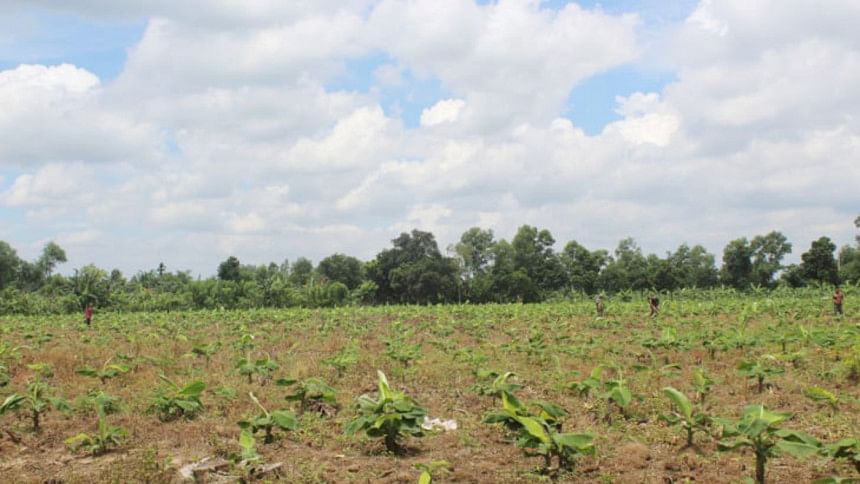Tangail’s traditional sal forest shrinking fast

While the country prepares to observe International Day of Forests tomorrow, the pitiable condition of the traditional sal forests in Tangail district worries environmentalists and conscious citizens.
Once a large, dense forest and habitat of a variety of wildlife including tigers, peacocks and langurs, the natural forest now sees plantations of different fruits and vegetables like pineapple, banana, jujube, guava, mango, lemon, papaya, arum, turmeric, ginger etc, where harmful insecticides and chemicals are commonly used.
The vast forests continue to shrink due to years of indiscriminate grabbing by locals as well as influential outsiders who also constructed different structures including concrete ones on the grabbed forestlands, for strengthening their possession.
With the increase of population, the local grabbers extend their dwellings and croplands. The process has continued for decades, foresters said.
Decades ago, the forests in Tangail were spread over 1,22,876 acres of land, including 45,565 acres in Madhupur; 47,220 acres in Sakhipur; 21,855 acres in Ghatail; 7,576 acres in Mirzapur; and 669 acres in Kalihati upazila, said Dr Jahirul Haque, divisional forest officer in Tangail.
Of it, 55,476 acres are reserved forests.
Besides, there are 17,436 acres of forests under Madhupur Garh region in adjacent Mymensingh.
Almost two thirds of the forests in Tangail, measuring around 80,000 acres of land, already disappeared due to indiscriminate tree looting and encroachment upon the forests, said sources at Tangail Forest Department.
The forest department in recent years recovered around 10,000 acres of forestlands, either through motivation or by force, while around 58,000 acres, out of the original 1,22,876 acres of forestlands, are still under the occupation of influential encroachers.

Meanwhile, the forest department in the last two decades leased out around 40,000 acres of forestlands in the district under the social afforestation programme.
Forest department officials said locals, outsiders, politicians, public representatives as well as government officials are among the plunderers of the forest.
"The forests could not be saved due to various factors including shortage of necessary workforce and logistics and interference by influential people, and," said Jamal Hossain Talukder, assistant forest conservator (North) of Tangail Forest Department.
"When we go to recover any grabbed forest land, the vested interest groups take different techniques including raising the issue of the local ethnic communities. Phone calls also come from powerful quarters," he said.
"On several occasions, we attempted to recover the grabbed forest lands with the help of local administration but failed.

"A couple of years ago, a syndicate of 15 outsiders, most of them government officials, raised guava, jujube and pineapple orchards after grabbing around 100 acres of forest lands at Pochachana village in Madhupur upazila.
"A firing range of Bangladesh Air Force was set up at Rasulpur in Madhupur upazila on 320 acres of forestland in 1978. They have extended the area and leased a portion of the land to locals for cultivation," he said.
The official also urged shifting all human habitations in the forest areas to outside.
Support from all concerned quarters is needed to recover the grabbed forest lands, said Dr Jahirul Haque, divisional forest officer in Tangail.
VERSION OF LOCAL ETHNIC LEADERS AND FOREST DWELLERS
Ajoy-a-Mre, a dweller of Madhupur forest and also president United Council of Indigenous Organisations of Greater Mymensingh, said the massive destruction of the forest started during 80s when the forest department started rubber plantation on the natural forest.
"Social afforestation programme is one of the main reasons behind disappearing of a large area of the natural forest in the region. Many influential people as well as outsiders got the plots under social afforestation. This gave the outsiders opportunity to enter the forest and grab the lands after clearing natural forest.
"The authorities should give responsibility of taking care of the forests to the villagers, not any individual," said the leader belonging to Garo community.
Eugene Nokrek, president of Joinshahi Adivasi Unnayon Parishad, said, "Local ethnic communities are not grabbers of the forest lands. Their forefathers started living in the area long before the Forest Act of 1927 was made."
A good number of people including 25,000 indigenous people live at 44 villages inside the Madhupur forest and the authorities should take into account their interest while making any plans regarding the forestlands, he added.
OPINION OF ENVIRONMENTALISTS
Somnath Lahiri, a senior researcher of Bangladesh Environmental Lawyers Association, blamed social afforestation as one of the main reasons behind rapid degradation of the natural forest.
Instead of preserving the natural vegetation, the forest officials have long been encouraging the people to plant alien acacia trees, he said.
The environmentalist emphasised creating 'Forest Villages' following models of India and Nepal to save the existing forests as well as reviving the natural forests with the participation of the local people.
"The mindless destruction of natural forest is not only destroying the bio-diversity and ecological balance but also effecting climatic changes," said Prof Sirajul Islam of the Department of Environmental Science and Resource Management at Mawlana Bhasani Science and Technology University.
"A state-level decision as well as a crash programme, like the ongoing river recovery drive, is needed for stopping tree felling in the sal forest in Tangail. It will help to eventually revive the natural forest," he said.

 For all latest news, follow The Daily Star's Google News channel.
For all latest news, follow The Daily Star's Google News channel. 



Comments